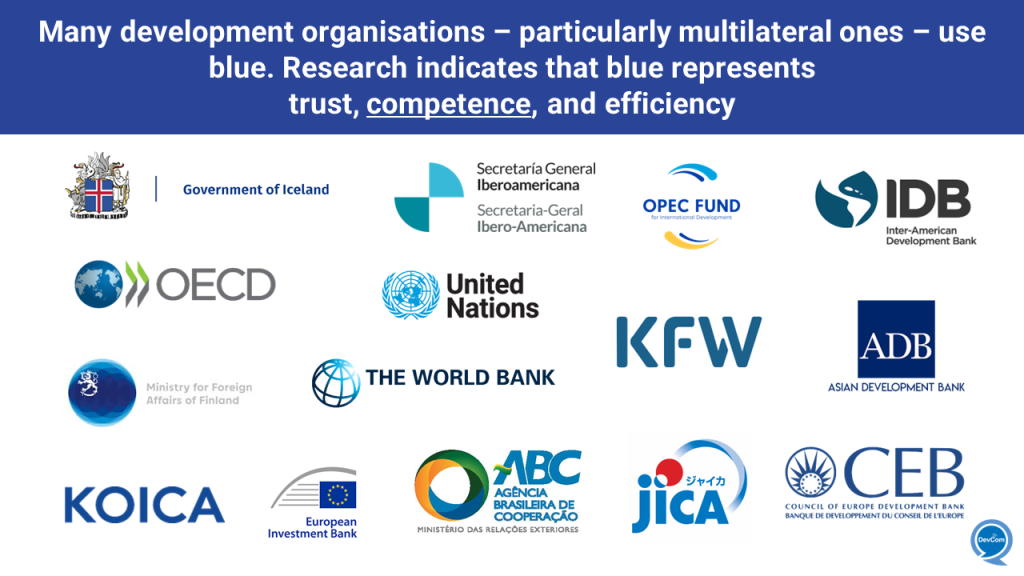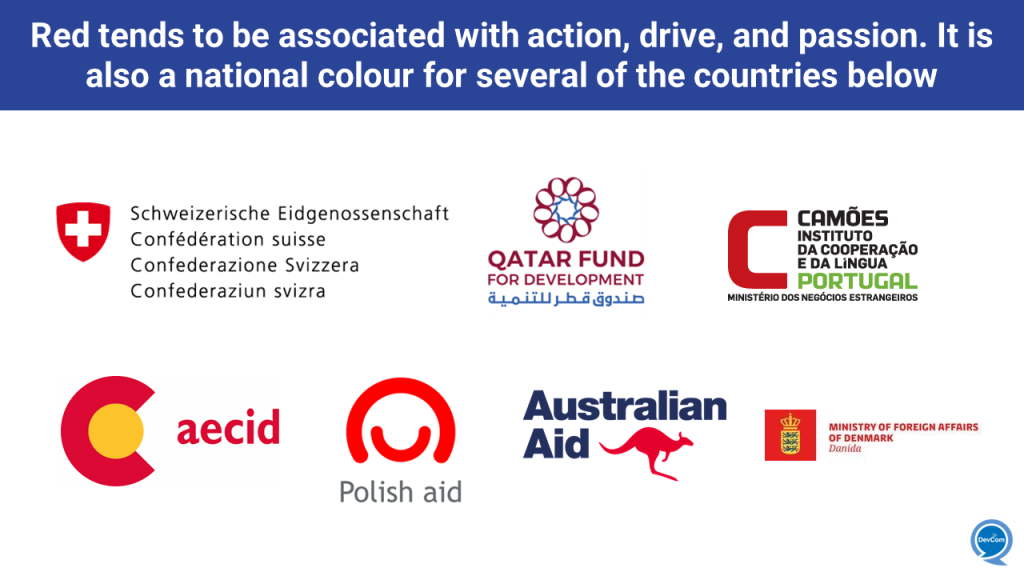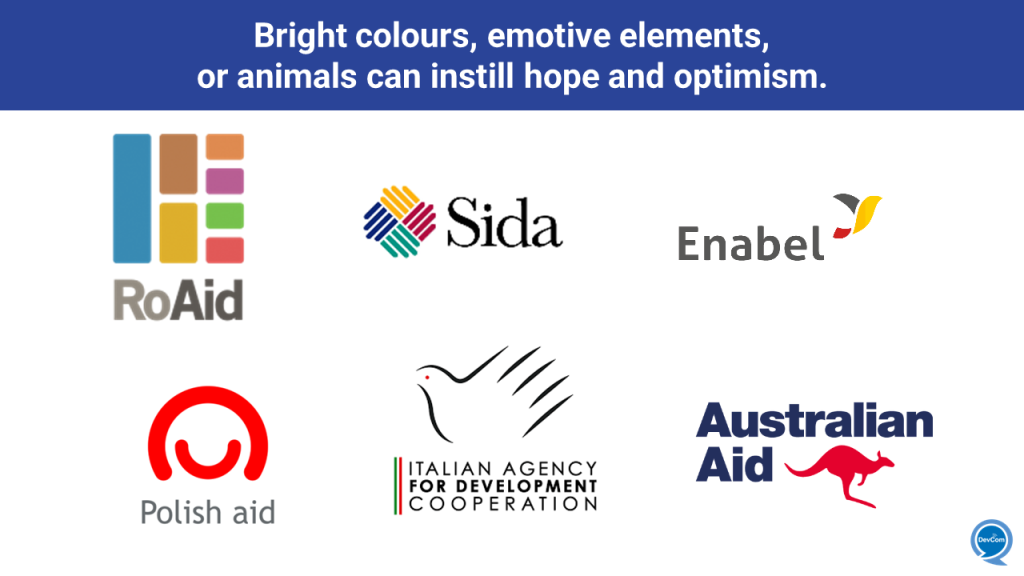What image does your organisation want to convey about development work? What feelings do you want to evoke among your audiences? Does your organisation need a rebrand?
Amid geo-political tensions and multiple crises, many governments are reviewing their development co-operation priorities, policies and budgets. These strategic changes have major implications for how development organisations position themselves.
So do the images and words they use still capture their goals and values? Are their branding choices adapted to the modern digital media landscape?
This post looks at trends in branding development co-operation, with a focus on three branding challenges: (1) defining an organisation’s values and identity; (2) choosing the right look and feel; and (3) setting branding policies and guidelines.
Branding Challenge #1: Defining Who You Are
A brand is much more than a logo. It is one of your organisation’s most important assets and part of achieving an organisation’s vision and mission.
So what is the vision that development organisations might want to convey today? Here are some reflections, based on the OECD DevCom Toolkit.
- Development work brings universal value. Alongside results abroad, it generates many benefits at home. It promotes a better world, creating jobs, boosting health, fostering climate action, and encouraging peace and stability.
- Development co-operation is an investment. It is no longer just about “aid” or “charity”, or about rich benefactors lifting poor victims out of poverty.
- Sustainable development is not achieved by one organisation but depends on a broad societal partnership. Credit and blame need to be shared.
When crafting a mission statement, development organisations must consider their language very carefully. For example, terms like “aid” can carry colonial connotations. This is increasingly important as development organisations see their legitimacy, trustworthiness and reputations being challenged in many of their partner countries.So how do today’s development organisations describe their work? We found that the concept of “aid” is still widely used in development branding (e.g. USAID, UAE Aid, UK Aid, Irish Aid, RoAid). However, new concepts are emerging, including togetherness, partnership and people.
Togetherness: We need joint action towards a shared vision
| ORGANISATION | MOTTOS AND TAGLINES |
| Enabel – Belgium | ‘’For a sustainable world where all live under the rule of law and are free to thrive.’’ |
| Sida – Sweden | “A better world together” |
| Agence Française de Développement – France | ‘’Let’s build a whole new momentum together for a common world in 2024’’ |
| OECD | ‘’Together, we create better policies for better lives’’ |
| Austrian Development Agency (ADA) – Austria | ‘’Better together” / “Shaping the future together” |
Partnership: All countries and actors are on equal footing
| Directorate-General for International Partnerships – European Commission | “We are responsible for formulating the EU’s international partnership and development policy” |
| World Bank | “A unique global partnership: five institutions working for sustainable solutions that reduce poverty and build shared prosperity in developing countries.” |
| UAE Aid – UAE | “Aid is continually provided to ensure the establishment of effective partnerships.” |
| Camoes Institute – Portugal | “To promote the economic, social and cultural development of its partner countries“ |
People: Development co-operation is about solidarity
| USAID – United States | ‘’From the American people’’ |
| Irish Aid – Ireland | “The Irish people’s overseas development programme’’ |
| UK Aid – United Kingdom | ‘’From the British people’’ |
Branding Challenge #2: Choosing Our Look and Feel
With a clear mission statement in place, organisations can reflect on their visual impact through logos, website design, campaign materials and more.
For development organisations, branding goals can be wide-ranging and may include promoting global solidarity, reflecting trustworthiness, or improving national image.
Logos
Logos are the face of an organisation. Business management and branding company Tailor Brands defines a good logo as one that is:
- Distinctive. Audiences should understand it immediately.
- Timeless. A good logo can be the face of your organization for decades. Brands with a clear and simple logo are more likely to stand the test of time.
- Relevant. It should accurately convey your mission and values.
- Versatile. It needs to work at any size and in all formats.
- Unique. It should set your brand apart from others, and not be easily forgotten.
There has been little research on whether development logos meet the above criteria. On this webpage, USAID explains the diverse components of its logo and the strategic rationale behind its branding. Yet, while this 2018 study on USAID branding in Bangladesh finds some positive effects, it also concludes that surprisingly few respondents understood the meaning of the USAID brand.
The following slideshow illustrates some of the branding choices development organisations have made. What do you think – do they meet the criteria proposed above?
Photos
Beyond logos, photography is an important part of an organisation’s brand recognition. Development organisations must be careful here, particularly if their photos depict people.
The development sector has often been accused of “poverty porn”, or of using tropes that depict Western leaders or celebrities as “saviours” and citizens of partner countries as beneficiaries with no agency.
Such images can be tempting to use. In a 2023 survey of UK citizens by the Development Engagement Lab, approximately 40% of respondents expressed a willingness to donate to development causes after viewing negatively-charged images featuring urgent contexts and young people.
But these images risk reinforcing a development narrative of “them vs. us“, or giving the impression that decades of aid have not achieved anything. This calls for more positive hope-based narratives with photos that respect the dignity and privacy of their subjects.
For guidance, have a look at Radiaid’s questions to consider when using images of people. DevCom’s Do’s and Don’ts in Development Messaging also apply to the use of images.

Branding Challenge #3: Setting Branding Policies and Guidelines
Branding is indispensable, but that does not mean putting logos on everything. Indeed, development branding can have downsides. Development organisations face three strategic challenges:
- Branding abroad for visibility “at home”?
Traditionally, development organisations have focused their communications on audiences in countries that fund development co-operation, not on audiences in countries where they operate. Development organisations are accountable for their spending and need to demonstrate results. They also want citizens to feel positive about how their taxes or donations are helping make the world a better place.
These pressures lead development actors to adorn their development work abroad with logos. Yet, there is actually very little evidence to prove that such branding helps achieve communication goals. One study does find that showing UK citizens branded aid work increases public support, particularly among conservative voters.
But critics highlight the potential downsides of aid branding. By giving donors credit for development results, branding could undermine public support for local leaders or governments, undermining local ownership of development process. Branding could also lead to bad policy decisions. Worse still, it can be demeaning and undignified.
- Promoting oneself in an era of partnerships?
While branding aims to raise visibility for individual actors, development results usually come from collaboration. The challenge for development organisations is thus to explain how they have contributed to collective outcomes. This could even improve their reputation as team players. Organisations need policies for co-branding, and clear guidance on how paid project partners or grantees engage in branding.
- Sharing the microphone means letting go of control.
Marketing experts tell us that branding can improve job satisfaction and pride among employees. Indeed, it can help engage employees as ambassadors in the overall branding effort. This may be particularly important in the development sector, which thrives on its sense of purpose.
Yet, there are risks to more decentralized communications. Employees – especially leaders in the public spotlight – need training and guidance on their roles and responsibilities, and on upholding brand identity.
Branding guidelines of development organisations
To address the above challenges, many development organisations already provide external collaborators and employees with branding guidelines.
These guidelines can cover:
- the use of logos, colours and fonts (i.e. Irish Aid and Sida)
- the vision and values to be promoted (i.e. Global Affairs Canada and UK Foreign, Commonwealth & Development Office).
- The best ways to draft press statements and social media posts.
Here is an overview of branding guidelines used in the DevCom community.
| Organisation | Content of the branding guidelines |
| Australia – Department of Foreign Affairs and Trade (DFAT) | Colours, file formats, logos, and instructions on their use by organisations and contractors. |
| Austria – Austrian Development Agency – ADA | Logos and guidelines for funded publications, projects, websites, etc. |
| Canada – Global Affairs Canada | Colour palette, typography, and guidelines for photography, videography, images, and graphic elements for partners. |
| Finland – Ministry of Foreign Affairs | How to apply the MFA’s visual identity. |
| France – French Development Agency (AFD) | Logos and other visual materials for partners. |
| Germany – GIZ | Special regulations for contractors, and guidelines on how to use the GIZ’s logo. GIZ’s style guide and other templates. |
| Ireland – Irish Aid | General advice on using the Irish Aid logo, and the organisation’s authorisation process. |
| Italy – Agency for Development Co-operation (AICS) | Guidelines on narrative, use of the AICS logo, and rules for printed materials, press releases, and social media. |
| Norway – Norwegian Agency for Development Cooperation (NORAD) | How to use its logo. |
| OPEC Fund for Development | How to use its logo in different settings and formats; elements of typography, fonts, and colour palette. |
| Poland – Polish Aid | How to use its logo, and graphics for download. |
| Spain – Agencia Española de Cooperación Internacional para el Desarrollo (AECID) | Corporate identities, and instructions for using its logo |
| Sweden – Swedish International Development Co-operation Agency (SIDA) | Logos in Swedish and English, and instructions on their use. |
| United States – USAID | Branding resources (logos, templates, presidential and interagency initiatives), graphic standards, and FAQs. |
| United Kingdom – Foreign, Commonwealth, and Development Office | A branding checklist, logos, roles and responsibilities, guidance on where UK International Development or UK aid brands should not appear, UK aid logos, and co-branding instructions. |
What about you? Is your organisation considering a re-brand, or do you have recent experiences of organisational re-branding to share? If so, we want to hear from you! Contact us at dev.com@oecd.org !






0 comments on “Branding Development Co-operation: Time for a Re-Design? ”